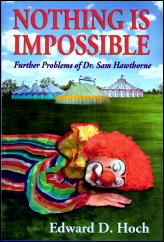Wed 11 Jun 2014
A Review by Mike Tooney: EDWARD D. HOCH – Nothing Is Impossible: Further Problems of Dr. Sam Hawthorne.
Posted by Steve under Reviews[4] Comments
EDWARD D. HOCH – Nothing Is Impossible: Further Problems of Dr. Sam Hawthorne. Crippen & Landru, 2014. Introduction by Janet Hutchings. Collection: 15 stories from EQMM.
For Edward D. Hoch (1930-2008), mysteries were primarily about plot, with characterization necessarily taking second place. The knottiest kind of mystery plot has always been the “locked room” or “impossible crime” story, which of necessity calls for more than the usual amount of cerebration on the parts of both the writer and the reader, who is expected to participate in the “game” of “howdunnit” set up by the author.
During his career, Hoch outdid even the grand master of the locked room mystery, John Dickson Carr, in the number and variety of his plots, churning out these brainbusters on a production line basis.
Hoch had several series characters threading their way through his nearly one thousand short stories, among them Ben Snow, Simon Ark, Rand, Captain Leopold, Nick Velvet, and Dr. Sam Hawthorne. It was in the stories of that last worthy, a New England general practitioner, according to Janet Hutchings (Hoch’s editor at Ellery Queen’s Mystery Magazine, EQMM) in her introduction, that “one finds some of the best Hoch plots, perhaps because he liked to save the most difficult kind of puzzle, that of the locked room, for his country doctor.”
Hutchings contrasts Dr. Sam with one of Agatha Christie’s series characters:
“As a young single doctor, Dr. Sam is involved in all kinds of relationships — personal, professional, and civic — with characters who turn out to be suspects, victims, and witnesses. He has a stake in what happens that goes beyond achieving justice, and his supporting characters become more important, as the series progresses, than they ever could be were his primary role that of observer.”
Thus Hoch was able “to create a milieu that readers could look forward to returning to again and again.” His entire series of Dr. Sam stories would begin in 1922 (the Roaring Twenties), pass through the Depression Thirties, and end (due to his death) in 1944 (the War Years), with the ones in this collection covering the period from early 1932 to late 1936.
If you like impossible crime stories that are puzzling without being disappointing in their solutions then Edward D. Hoch’s Dr. Sam Hawthorne stories are a good place to go. Unless you’ve collected just about every issue of EQMM since 1974, however, it’s unlikely you’ll have the complete series, which is why you’d do well to get this book — and the two previous Dr. Sam collections issued by Douglas Greene’s fine publishing house, Crippen & Landru.
— NOTE: A slightly different version of this article appeared on The American Culture website.

June 12th, 2014 at 9:32 am
The previous two Dr Sam collections are:
Diagnosis: Impossible (1996) and
More Things Impossible (2006).
Other collections of Ed Hoch’s stories from Crippen & Landru are:
The Ripper of Storyville and Other Ben Snow Tales (1997)
The Velvet Touch (2000; Nick Velvet)
The Old Spies Club and Other Intrigues of Rand (2001)
The Iron Angel and Other Tales of the Gypsy Sleuth (2003; Michael Vlado)
All recommended!
PS. My interview with Mr. Hoch can be found online here:
https://mysteryfile.com/Hoch.html
This interview took place in 2004, a year before I met him in person at the annual Pulpcon convention. The nicest man you could ever hope to meet. If the word gentleman wasn’t already in the dictionary, I’d have to invent it to describe him.
June 12th, 2014 at 4:59 pm
My least favorite Hoch series meaning it was still better than at least 80% of everything else.
I always read the Hoch first in EQMM and AHMM, then the Clark Howard novella. Everything else came second.
June 13th, 2014 at 3:17 pm
Just recently read the first of the Hawthorne books, and am part way through the second. Also reading the first Velvet collection. Makes me feel like a cartoon I once saw: Two egyptologists stand in front of a tiny little pyramid poking out of the sand. One says to the other “If this is what I think it is, we’ve got a hell of a lot of digging to do!”
There are a hell of a lot of Hoch short stories to read!
December 26th, 2020 at 9:41 pm
[…] Things Impossible (2006) (15 stories) Nothing Is Impossible (2013) (15 stories) (reviewed here […]